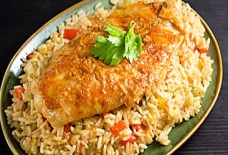Midwestern ingredients give hummus local flair
By Tony and Sarah Nasello
Detroit Lakes Online
Did you know that May 13 was International Hummus Day? According to Wikipedia, this “holiday” began in 2012, but beyond that there is scant information about how this day was designated or by whom. In fact, I’d hazard a guess that there isn’t a specific governing body to oversee these honorifics, at least not yet.
With the advent of social media, there seems to be a daily special designation for nearly any topic you can imagine — food, culture, places, art and even animals. Unfortunately, I usually learn about these new holidays ex post facto, as I scroll through my Twitter feed before falling asleep.
No matter. We relish any opportunity to celebrate the wonderfulness of hummus, a Middle Eastern creation of pureed chickpeas, tahini (sesame seed paste), lemon and garlic. And since there doesn’t seem to be any hard and fast rule to the creation of these specialty days, I’m sure no one will mind that we’re a few days behind the curve on this one. Maybe we could label May 18 as “North Dakota Hummus Day” or “Upper Midwest Hummus Day”?
The word hummus is Arabic in origin and means simply chickpeas. Also known as garbanzo beans, chickpeas are currently having a moment in the world of food, as are all the grain legumes (called pulses), like lentils, dry peas and dry edible beans. In fact, the United Nations has officially designated 2016 as “The Year of the Pulse.” While this may seem like just another random honorific, the intention behind this declaration is to promote pulses as an excellent source for protein and vital nutrients.
We can’t argue with that logic. Pulses are high in protein and fiber, low in fat and rich with iron, zinc and health-boosting antioxidants. These foods are filling, easily available and often very affordable, which makes them a great protein option, especially in those parts of the globe where severe hunger is an everyday issue.
Adding pulse foods to your daily food regimen isn’t just good for you, it’s also good for our region which leads the nation in the production of pulse crops, with North Dakota at the top. Tony and I are avid supporters of our local agricultural community and love to create recipes that are inspired by the crops surrounding us.
While the presence of chickpeas are what makes a hummus authentic, you can add other ingredients to change the flavor and reflect your region. Two years ago we shared a recipe for corn hummus, and today we are featuring a traditional chickpea hummus garnished with smoked paprika, as well as a local variation made from a blend of chickpeas and edamame (immature soybeans), garnished with crushed soy nuts.
Hummus is an excellent way to introduce chickpeas and other local pulse crops into your diet, and can be enjoyed either as a dip, sandwich spread or condiment. It is easy to make, especially if you use a food processor or blender to combine the ingredients, which creates a smoother texture than if mixing by hand. We have included measurements in our recipes as a guide, and encourage you to start with the lower amount and taste your hummus as you make it, adjusting the ingredients according to your taste.
If you’d like more instruction, join me at the Women’s Health Conference this Monday, May 23, where I’ll be giving three presentations featuring some of my favorite North Dakota-inspired healthy recipes, which just happens to include hummus.
“Home With the Lost Italian” is a weekly column written by Sarah Nasello featuring recipes by her husband, Tony Nasello. The couple owns Sarello’s in Moorhead and lives in Fargo with their 11-year-old son, Giovanni. Readers can reach them at dine//thelostitalian.areavoices.com.
Traditional Hummus
Two 15-ounce cans chickpeas, drained but reserve liquid
4 to 5 garlic cloves, minced
2 tablespoons extra virgin olive oil
Juice from 1 to 2 lemons (1 to 3 tablespoons)
¼ cup tahini paste
½ teaspoon cumin
1 teaspoon kosher salt
½ teaspoon black pepper
Smoked or plain paprika (for garnish)
Roasted chickpeas (for garnish)
In a food processor or blender, add the chickpeas, garlic and olive oil and pulse just to combine. Add the remaining ingredients and blend until well combined, adding the reserved bean liquid (or water) through the feeder tube until desired consistency is achieved.
Taste and adjust seasoning and spices as desired. Sprinkle top with smoked or plain paprika or roasted chickpeas. Serve immediately or refrigerate for up to 1 week. Serve with sliced warm pita bread, hearty crackers, fresh veggies or in a wrap or sandwich.
Spicy Edamame Hummus
1 cup edamame, shelled
1 15-ounce can chickpeas, drained but reserve liquid
3 to 4 garlic cloves, minced
3 tablespoons extra virgin olive oil
¼ cup tahini paste
Juice from 1 to 2 lemons (1 to 3 tablespoons)
¼ teaspoon cayenne pepper — add more to increase heat
10 drops hot sauce (Tabasco or your favorite)
1 teaspoon kosher salt
½ teaspoon black pepper
Roasted and salted soy nuts (for garnish)
Bring a pot of water to a rolling boil; add edamame and cook for 5 minutes. Drain and rinse with cold water.
In a food processor or blender, add the edamame and pulse 8 to 10 times.Add the chickpeas, garlic and olive oil and pulse again until coarsely ground.
Add the remaining ingredients and blend until well combined and smooth, adding the reserved bean liquid (or water) through the feeder tube until the desired consistency is achieved. Taste and adjust seasoning and spices as desired. Crush some roasted and salted soy nuts and sprinkle over the top.
Serve immediately or refrigerate for up to one week. Serve with sliced warm pita bread, hearty crackers, fresh veggies or in a wrap or sandwich.
Source: www.dl-online.com


